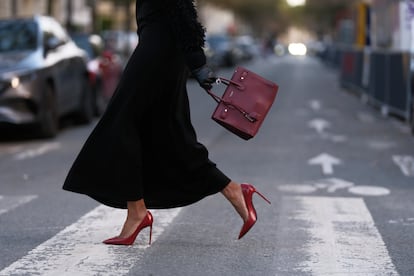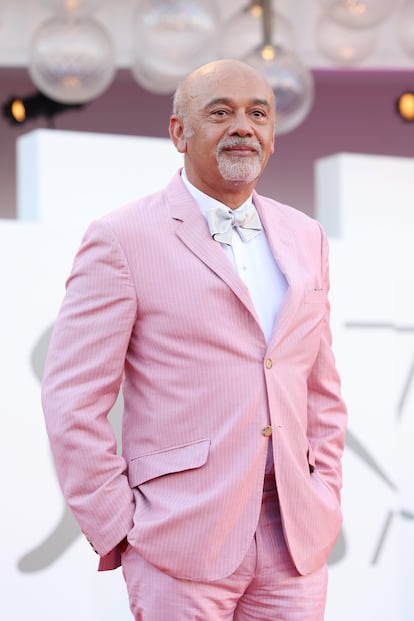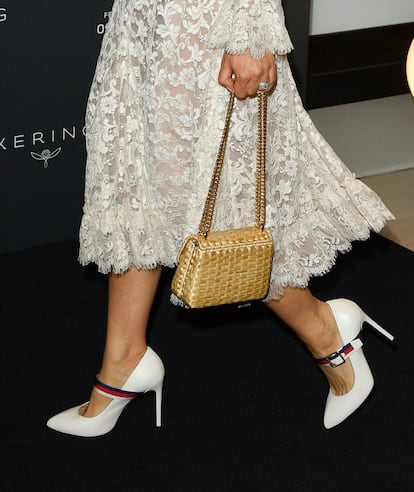Uncomfortable and bad for your health: Why do women still wear high heels in 2023?
In the era of comfort, stilettos continue to be an object of desire

Christian Louboutin, the famous shoemaker who elevated sky-high stilettos to a luxury fetish, once said that the fascination with heels lies in the fact that they make women go slower, giving men more time to admire them. He didn’t comment on their aesthetics or beauty; his only appreciation was that of speed: “What is the point of wanting to run? When a woman wears heels you have time to look at her. She walks, she is not going to run (…) It is almost like a mirage (…) Why would she want to run? Where would she want to run? What’s the point?” he asked himself.
He made those statements ten years ago, in 2013, in a conversation with the French photographer Garance Doré, who at that time was omnipresent in the Parisian creative scene and who captured them in a video recorded at Paris Fashion Week. In just 10 minutes, she and eight other women in the world talked about the painful fascination that walking on stiletto heels produces for them. Anna dello Russo, the ubiquitous and extravagant editor of Vogue Japan, said that if you wear heels “your ego goes to the sky,” while when you go flat “you feel like a mouse.” And she added that at fashion week you need an extra dose of confidence that only high heels can give you.
Many legendary phrases have been said about stilettos and their supposed power of attraction. On one occasion, the actress Salma Hayek —one of the legends of Hollywood and married to François-Henri Pinault, president and heir of the Kering luxury empire, owner among others brands such as Gucci, YSL, Bottega Veneta and Balenciaga— stated that “if it had not been for my high heels, I would still be in Coatzacoalcos and have 10 children.” Victoria Beckham also famously sad that she cannot concentrate if she wears flat shoes. In mid-2023, those statements sound, to say the least, somewhat outdated, and yet the heel business is flying high: according to a report published by the research and advisory company Technavio in November 2022, the high-heeled footwear market will grow 1.88% annually between 2022 and 2027. This will result in an accumulated profit of $2.39 billion during that period, a phenomenon around the world. The countries that will buy the most high heels are the United States, China, the United Kingdom, Germany and France. At the same time, it is estimated that consumption from the Asia-Pacific region is increasing.
“One of the conclusions of the report is that heels are going to stop being necessary accessories and become exclusively ‘premium’ accessories with even higher prices. This is what is significantly driving the growth of the high-heeled footwear market,” explains Úrsula Carranza, expert fashion journalist and author of the book Tacones de Culto (Loft Publications). Most of these shoes, she adds, will be purchased online.
In an era in which comfort has taken over fashion trends, and after movements like #MeToo that have questioned the role of women in society, it is worth wondering why so many women continue to wear stilettos today. Yes, as Louboutin advanced, they are the most uncomfortable option: he once stated, “I would hate for someone to look at my shoes and say: Oh my God, they look so comfortable!” It is known that their daily use is bad for your feet. So what makes us continue to wear heels?
“Louboutin’s comment is in line with his designs, because he is a designer who loves to provoke both with what he says and with what he creates. Louboutin is a designer who does not focus on the comfort of high heels, but on the aesthetics, luxury and sex appeal they project. Those have been his priorities, and thousands of women have identified with his designs. It is part of his brand identity and the reason why his heels have become iconic,” notes Carranza.

As writer and journalist Summer Brennan points out in an article on the subject published in The Guardian, the high heel is today the most acceptable public footwear for women. “It is a shoe for events, display, performance, authority and urbanity. In some settings and on some occasions, usually the most formal, it is even required. High heels are something like neckties for women, in that it can be harder to look both formal and femme without them,” writes Brennan, author of High Heel. It is a shoe “for magazine covers, red carpets, award shows, boardrooms, courtrooms, parliament buildings and debate lecterns,” the writer adds.
The cinema perfectly portrayed it as a requirement for applicants for high positions in the 1988 film Women’s Weapons, where Melanie Griffith changed her sneakers upon arriving at the office. While heels have no practical function, they seem to provide a certain power, status and ability to metamorphose in return.
In the nineties, they were the feminine corporate uniform par excellence. In recent years, some have challenged the norm of heels at work. In 2019, Japanese women stood up to their government to demand not wearing heels to work in a movement that received the name #KuToo. They sought to end the “discrimination and sexual harassment” involved in being forced to wear heels. The creator of this initiative was Yumi Ishikawa, a well-known 32-year-old actress and model, who involuntarily started the movement by writing a tweet explaining her suffering from having to wear high heels every day. A couple of years earlier, in Spain, flight attendants from different airlines had raised their voices against the so-called “stewardess feet:” “You can’t even imagine the bunions, nails, calluses. It makes your job so much harder. I know many colleagues who have had to have surgery. And the important thing is no longer just the heel, it is the tip of that heel, which they require to be round and narrow, arguing that the shoe has to be pretty. I am sure that if men had this problem it would have changed,” a flight attendant told EL PAÍS.
An invention designed for men
Paradoxically (or not), throughout history heels have been a claim to power, a piece of oppression and a shoe for sex. But as often happens in fashion, an object that was born for one purpose ended up serving the opposite.
High heels began as an invention designed for men. It wasn’t designed for walking: the high heel was used for centuries throughout the Near East as a form of riding footwear and was used on horseback by the Persians.
It is believed that it was the Sun King, Louis XIV (1638-1715), who first used it as fashionable clothing, probably because of his small stature. The trend spread like wildfire in the French court. As José María Amat Amer, founder of the Elda Footwear Museum, explains in an article in El País, “coturns, with high platforms, were used in ancient Greece. In Asian and even European countries, riders who fought on horseback wore shoes with heels, to attach more securely to the stirrups. The men and women of ancient China also wore platforms, just like the Venetians who, since the 15th century or even before, used a type of hike, probably to navigate flooded areas.”
By the time the 20th century arrived, the heel had reached the women’s wardrobe. Skirts were shortened, so the ankle, and the shoes, began to be visible. Feminists of the time began to show their footwear — in fact, the five-centimeter heels that women used to wear in marches asking for the female vote are known as suffragette boots — and showing the shoe was considered a symbolic gesture of independent women, an idea that has somehow survived over time: the higher the heels, the more freedom there is possible.
The heyday of the women’s heel came in the 1950s, when Dior designer Roger Vivier placed steel rods in the shafts of thin stiletto heels, raising their height to three inches or more and encouraging women to wear them in daily life. Thus, in the postwar era, when the emergency female workforce had returned to the kitchen, the model for the contemporary high heel made its debut.
Vivier, of French origin, had been making custom high heels for women like Josephine Baker and Queen Elizabeth II since the 1930s. He was one of the first conventional designers to take his creations to the limits of practicality and the realm of art. He was not the first to use steel in his heels, nor were his shoes the first to feature very high, thin heels, but it was his work with Dior in the 1950s that shaped the image of women of the time.

This shoe received its own name. “The stiletto, which is characterized by its high, thin and pointed heel, has managed to leave its mark on popular culture over the years. It symbolizes elegance, glamour and style. It has always been an inspiration for designers, models and celebrities, as well as a recurring element on catwalks, red carpets and the advertising campaigns of luxury brands. Cinema has contributed to perpetuating the popularity of this type of shoes and identifying them as symbols of power, self-confidence and sensuality. We can see it in films like The Seven Year Itch where Marilyn Monroe appears with stilettos and more recently in series like Sex and the City where the protagonist Carrie Bradshaw is a fan of high heels,” states Úrsula Carranza.
The high heel has also had another meaning: that of the shoe for sex. One of the photographers who best portrayed the fetishism of heels was Elmer Batters (1919-1997), who captured an entire universe of feet, stockings and high-heeled shoes in his photographs and who suffered the censorship of the puritan fifties, taken to court for obscenity and perversion.
From those creations of Roger Vivier to those of more recent renowned designers such as Manolo Blahnik, Christian Louboutin and Alexander McQueen, modern high heel designs have evolved. Their luxurious designs transform women almost into something more than human (after all, they are neither useful nor practical), placing them on a pedestal: elevated, but also easier to trap or subdue.
Indeed, you can’t go very far on heels. As Louboutin himself explained in the conversation above, when you put on heels the whole body stands up and the center of gravity changes. The body is forced towards the front, so a woman, to maintain the correct center of gravity, needs to bend, repositioning their chest forward and curving their lower back. Today, certainly, the idea of this presentation grates on current ideals. As Rita Abundancia wrote in EL PAÍS, “there is no shortage of those who compare heels to corsets, crinolines and other instruments of torture, oppressive forms that have modulated female bodies at will because a woman in movement, outside of male control, has long been seen as a danger. The Chinese bound their girls’ feet to make them small, turn them into stumps and make sure their owners couldn’t go far. In the fifties, after the Second World War, when women returned to the home and their position as housewives after having replaced men in their tasks and in factories, fashion moved them to uncomfortable stiletto heels, which they had to wear all day if they wanted to be feminine and desirable.” What better way to tame women who want to flee than to root them in the ground?
So can heels be a feminist choice? “What confines, impoverishes, exploits, enslaves, oppresses, sickens, bloodies, rapes and kills women are not generally clothes or shoes, but rather laws and societal norms,” says writer and journalist Summer Brennan in a article on the subject in the English newspaper The Guardian. And she lists a long list of culprits: “prejudice,” “misogyny” and “white supremacy,” among others.
“If you believe, as feminism dictates, that women should be able to freely wear whatever they want, whether that means wearing high heels or not, then yes, wearing a high heel could be considered a feminist choice,” says Úrsula Carranza. “However, if you do it purely to meet certain societally imposed norms or certain gender expectations, then no. It is a complex and debatable topic. For me, high heels represent an artistic choice,” she adds.
This writer has her own theory about why we still wear heels today: “One of the most attractive things about heels is the ability they have to transform the woman who wears them. The magical change that occurs in a woman’s posture, height and way of moving when she stands in heels is a sensation that women enjoy and value. It is an almost objective fascination. Heels go from being simple accessories to being elements that allow you to reinvent yourself. The psychological effect makes women feel safe and empowered,” she says.
If you add to that that technology today allows for more comfortable high heels, you find another reason why many women continue to opt for them. “In recent years there has been a stronger emphasis on comfort and functionality in the design of heels. Brands and designers are increasingly aware of the importance of combining style with functionality to meet the preferences of an increasingly diverse customer base,” says Úrsula Carranza. “The comfort of heels can vary greatly from person to person, depending on foot shape, design, and personal preference. In general, heels between 5 and 7.5 centimeters are considered relatively comfortable for prolonged wear. Adequate arch support, cushioned insoles that provide good cushioning, as well as the design of the shoe — for example, round or almond-shaped toes tend to be more comfortable than pointed ones — and the quality of materials can play a role in comfort. Wider heel bases provide greater stability while wedge heels tend to be more comfortable than stilettos. Platforms can help distribute weight more evenly. The different heel heights allow us to adjust our level of comfort.”
The stiletto scholar focuses on four recent creators who are changing the heel industry: “I would highlight Edgardo Osorio, from Aquazzura, because his heels are original, modern and cheerful. Andrea Wazen is a young Lebanese designer who is part of the new talent of Middle Eastern designers who are innovating with her creations. Her designs are unique, glamorous and feminine and she combines materials such as tulle, glitter and transparencies in creations that look like haute couture clothing. Ada Kokosar is the talented Italian designer of the fun Midnight 00 brand that is inspired by the world of dreams and fantasy. Handmade with haute couture techniques, the creations of Kokosar, who used to be a fashion stylist, have a unique and recognizable aesthetic that sets them apart from the rest. One of her original designs was part of one of the fashion exhibits at the Metropolitan Museum in New York. Lastly, I would mention Julien Martínez from the Spanish-French brand Souliers Martínez. A lover of the braided leather technique and preserving artisanal techniques, Martínez designs heels that are inspired by beautiful and timeless silhouettes that surpass trends and the passage of time.”
As writer Summer Brennan mentions in her book High Heel: “In her book Bad Feminist, writer Roxane Gay defends stereotypically ‘feminine’ things like her love of pink, rejecting the idea that feminism should exclude symbols of feminine culture. ‘Can we claim power as women without also denigrating femininity? Can’t even cultural femininity be rescued from patriarchy and its metaphors of oppression?’ she asks. The truth is that the idea of femininity is something cultural.”
“Fashion is not about utility. An accessory is merely a piece of iconography used to express individual identity,” said Meryl Streep in her role as the all-powerful fashion magazine director in the film The Devil Wears Prada. “Fashion is definitely a way to express your personal style, your aesthetic preferences, your way of seeing life. What you wear and how you wear it says a lot about you and your personality. Today more than ever, clothing is a dynamic and versatile medium to express a person’s identity and communicate with the world. Whether through classic, bohemian, minimalist or eclectic garments, or if you are one of those who follow trends or prefer vintage garments or artisanal creations, women have more opportunities than ever to use clothing as a powerful tool of expression, which can have an impact on both personal and professional life,” reflects Úrsula Carranza.
Sign up for our weekly newsletter to get more English-language news coverage from EL PAÍS USA Edition









































